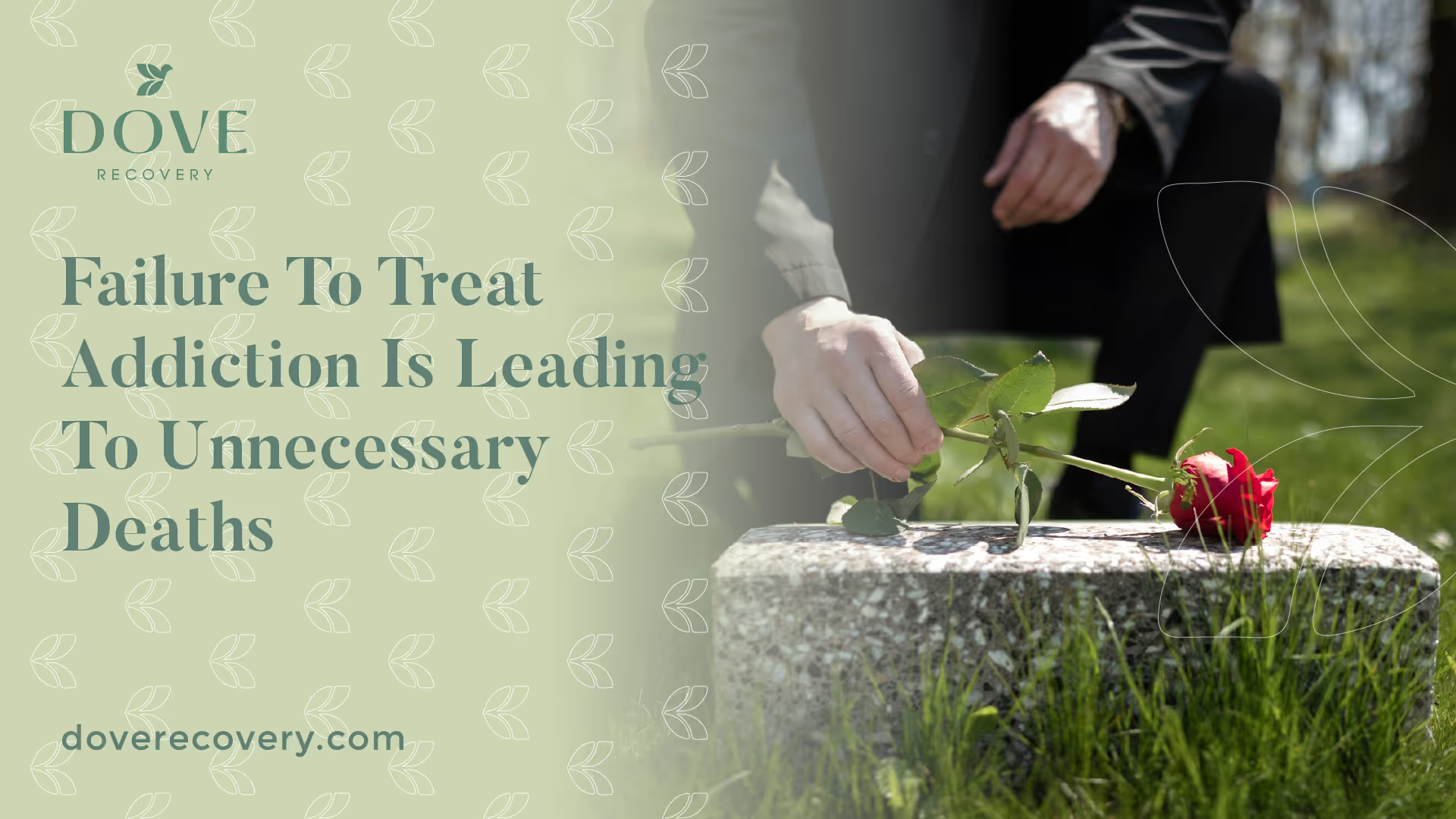Failure To Treat Addiction Is Leading To Unnecessary Deaths

The Impact of Untreated Addiction
Untreated addiction has a devastating impact, both on the individual suffering from the addiction and society as a whole. The failure to treat addiction is leading to unnecessary deaths, with overdose and mental health complications being two of the primary causes.

Prevalence of Substance Abuse
Substance abuse is a prevalent issue, with a significant number of individuals affected by it. A study found that there is a high prevalence of alcohol and drug abuse, with the majority of drug users not seeking treatment. This lack of treatment poses a significant concern for professionals in the field and society at large.
This table shows the prevalence of various substance abuses. It's important to note that these figures are likely to be underestimated due to the stigma associated with drug use and the reluctance of individuals to disclose their drug use.
Psychological Barriers to Seeking Treatment
There are numerous barriers that prevent individuals from seeking treatment for substance abuse. Notably, psychological well-being is cited as a major reason for not seeking treatment. Factors such as the short-term beneficial effects of drugs, lack of awareness about drug-related complications, fear of withdrawal symptoms, and unawareness of treatment facilities also play a role [1].
On the other hand, among those who do seek treatment, the most common motivation is the desire to improve oneself. Other motivations include the availability and awareness of treatment facilities, internal motivation, and ease of access to treatment resources.
Failure to treat addiction can lead to overdose and death, especially in the case of opioids. Furthermore, individuals with mental disorders may turn to drug use in an attempt to alleviate psychiatric symptoms, which can worsen their mental condition in the long run and increase the risk of developing an addiction. This underscores the importance of addressing mental health disorders and addiction simultaneously to prevent unnecessary deaths [2].
Consequences of Untreated Addiction
The repercussions of untreated addiction are far-reaching, with implications for both individual health and societal wellbeing. The failure to treat addiction is leading to unnecessary deaths and causing a significant strain on various sectors of society.
Drug Overdose and Death
One of the most devastating outcomes of untreated addiction is drug overdose, which can often lead to death. This is particularly the case with opioids, highlighting the critical importance of timely intervention and treatment for individuals struggling with addiction. Substance misuse and substance use disorders directly affect millions of Americans every year, causing motor vehicle crashes, crimes, injuries, reduced quality of life, impaired health, and far too many deaths.
Societal Impact of Addiction
The societal impact of untreated addiction is profound and far-reaching. Beyond the individual with the addiction, drug misuse can cause serious health problems for others, contributing to unnecessary deaths within communities.
Addictions of all kinds, such as drugs, alcohol, nicotine, gambling, and eating disorders, result in substantial costs to individuals, families, and society. They may lead to crime and violence, costing employers and taxpayers approximately $590 billion annually in lost productivity and medical treatment.
Only 10.4 percent of individuals with a substance use disorder receive treatment (National Library of Medicine), underscoring the urgent need for accessible and effective addiction treatment. The societal burden of untreated addiction, both in terms of financial cost and human lives, emphasizes the importance of addressing this public health crisis.
Barriers to Addiction Treatment
Identifying and addressing the barriers to addiction treatment is a crucial step towards mitigating the crisis. The failure to treat addiction is leading to unnecessary deaths, and the issue is particularly pronounced in certain communities and demographics.
Rural Community Challenges
Rural communities face a unique set of challenges when it comes to preventing and treating substance use disorders (SUDs). According to the Rural Health Information Hub, these communities often encounter barriers to developing effective programs for battling SUDs. A qualitative study involving rural healthcare providers also highlighted the challenges and lessons learned in treating SUDs, further indicating gaps in addiction treatment efforts.
One of the significant disparities between rural and urban areas is the availability of substance abuse treatment facilities. Rural regions often have fewer resources, services, and inpatient/residential beds for treating substance abuse, further compounding the problem of untreated addiction.
Barriers in Accessing Treatment
Accessing treatment for substance abuse is a significant challenge, not just in rural but also in urban areas. A study from 2014 highlighted that barriers to treatment exist in both demographics and could be resulting in unaddressed addiction issues and subsequent deaths.
According to NCBI, the majority of barriers and facilitators to SUD treatment are structural, followed by social and individual. These barriers can range from the inability to access or afford treatment, stigma associated with substance abuse, lack of awareness or understanding of available treatment options, and more.
Addressing these barriers and enhancing access to treatment is critical to tackling the addiction crisis and reducing the alarming rate of deaths associated with untreated addiction. Future sections will delve into the individual, social, and structural factors affecting addiction treatment and discuss potential strategies to address the addiction crisis.
Factors Affecting Addiction Treatment
The failure to treat addiction, leading to unnecessary deaths, is a significant issue in today's society. Multiple factors affect access to addiction treatment, and these can be classified into three categories: individual level barriers, social level barriers, and structural level barriers. Each category plays a distinct role in hindering individuals from seeking help and obtaining the necessary treatment for substance use disorder (SUD).
Individual Level Barriers
Individual level barriers to SUD treatment are primarily internal and personal factors that dissuade an individual from seeking treatment. These barriers include wrong beliefs about treatment, perceived fears, personal traits, and psychiatric comorbidities. Such factors may lead to a lack of motivation, denial of addiction severity, or an unwillingness to seek help due to existing mental health issues. Addressing these individual level barriers is critical in the process of encouraging more individuals to seek and receive proper treatment for their addiction.
Social Level Barriers
Social level barriers involve the societal and interpersonal factors that hinder an individual from seeking treatment for SUD. These include stigma and lack of social support, family factors, friends network, and problems with the therapeutic team. For instance, fear of social stigma can deter individuals from admitting their addiction and seeking help. Similarly, lack of family support or negative influence from peers can also discourage individuals from pursuing treatment. The therapeutic team's approach is also crucial, as a lack of empathy or understanding can create a barrier to effective treatment.
Structural Level Barriers
Structural level barriers are organizational and systemic factors that obstruct access to SUD treatment. These include problems related to treatment provider services, legal barriers, and policy barriers. Issues with treatment providers' services can range from inadequate facilities and resources to unavailability of specialized treatment programs. Legal barriers can include punitive laws and regulations that deter people from seeking help due to fear of legal repercussions. Policy constraints, such as lack of funding for addiction treatment programs and insurance coverage limitations, can also restrict access to necessary treatment [6].
According to studies, the most frequent barriers or facilitators to SUD treatment are at the structural level. Therefore, addressing these systemic issues is crucial to improving access to treatment and reducing the devastating impact of untreated addiction.
Addressing the Addiction Crisis
The failure to treat addiction is leading to unnecessary deaths, a crisis that calls for immediate attention and action. The barriers to treating addiction are manifold, ranging from workforce shortages in treatment facilities to the impact of the COVID-19 pandemic.
Workforce Shortages in Treatment
One of the major challenges in addressing the addiction crisis is the workforce shortage in addiction treatment. According to a report by the California Consortium of Addiction Professionals and Programs, the shortage is attributed to factors like retirement, compassion fatigue, and low salaries. This shortage extends to various behavioral health professionals needed to meet the demand for substance use disorder treatment.
These shortages are alarming, especially considering the rise in addiction rates. Before the pandemic, more than 120 people were dying from overdoses daily, highlighting the urgency of addressing the addiction crisis [7].
Impact of COVID-19 on Addiction Treatment
The COVID-19 pandemic has further exacerbated the addiction crisis. The isolation caused by the pandemic, combined with untreated addiction, could potentially lead to a number of deaths rivaling those caused by COVID‐19 itself, warns the CEO of the California Consortium of Addiction Professionals and Programs.
Moreover, the impact of the pandemic on addiction treatment includes short-term consequences for programs, with many ill-prepared to handle the expected increase in cases. Prior to the pandemic, addiction rates were already on the rise, along with the opioid epidemic, leading to an increase in deaths from alcohol abuse, drug overdose, and suicide.
Addressing the addiction crisis requires a concerted effort from all stakeholders, including policymakers, healthcare providers, and the community at large. The focus needs to be not only on increasing the availability of treatment facilities and professionals but also on creating supportive environments that encourage individuals to seek help without stigma or fear. The health and lives of countless individuals depend on these urgent efforts.
References
[1]: https://www.ncbi.nlm.nih.gov/pmc/articles/PMC2951651/
[2]: https://nida.nih.gov/publications/drugs-brains-behavior-science-addiction/addiction-health
[3]: https://www.ncbi.nlm.nih.gov/books/NBK424861/
[4]: https://www.ncbi.nlm.nih.gov/pmc/articles/PMC4070513/
[5]: https://www.ruralhealthinfo.org/toolkits/substance-abuse/1/barriers
